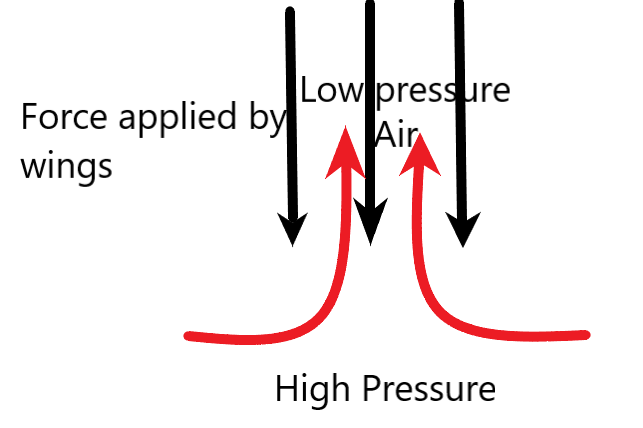
Birds glide effortlessly in the air with the help of –
A) Conduction of heat in the air
B) Radiation of light through the atmosphere.
C) Convection currents of air.
D) More sugar.
Answer
480.3k+ views
Hint: We need to understand the flying mechanism in birds and its relation with the air and other factors, which affect it. We need to relate the movement of birds with the movement of air in order to find the correct phenomenon which allows them to fly.
Complete step-by-step solution
The birds fly with the mechanisms involved in the wing movements. The movement of birds is only possible if the wings can produce an upward force strong enough to balance them in the air. We can easily understand that the downward force applied by the wing should enhance the upward movement of its body.
Let us consider the wing movement of the birds. The wings exert a strong downward force against the air under their wings. According to Bernoulli's principle, the velocity of a fluid is inversely proportional to the pressure of the fluid in that region. i.e., the pressure decreases with the increase in the speed of air.

In our situation, the bird is exerting a downward force which speeds up the air below the wing creating a low pressure under the wings. Due to the creation of low-pressure underneath, the air from the higher-pressure regions will move upwards. This upward movement pushes the bird upwards and hence enables flying.
This process in which fluids flow from high pressure to the low-pressure area is called the convection current of the fluid. Thus, the convection current of air helps the birds to glide in the air very easily.
The correct answer is option C.
Note: Besides the convection mechanism, the birds and other flying objects use the virtue of the streamlined motion for easy and resistance less flying. The streamlined shape reduces the air friction as the surface of contact of air is kept the minimum for smooth flying.
Complete step-by-step solution
The birds fly with the mechanisms involved in the wing movements. The movement of birds is only possible if the wings can produce an upward force strong enough to balance them in the air. We can easily understand that the downward force applied by the wing should enhance the upward movement of its body.
Let us consider the wing movement of the birds. The wings exert a strong downward force against the air under their wings. According to Bernoulli's principle, the velocity of a fluid is inversely proportional to the pressure of the fluid in that region. i.e., the pressure decreases with the increase in the speed of air.

In our situation, the bird is exerting a downward force which speeds up the air below the wing creating a low pressure under the wings. Due to the creation of low-pressure underneath, the air from the higher-pressure regions will move upwards. This upward movement pushes the bird upwards and hence enables flying.
This process in which fluids flow from high pressure to the low-pressure area is called the convection current of the fluid. Thus, the convection current of air helps the birds to glide in the air very easily.
The correct answer is option C.
Note: Besides the convection mechanism, the birds and other flying objects use the virtue of the streamlined motion for easy and resistance less flying. The streamlined shape reduces the air friction as the surface of contact of air is kept the minimum for smooth flying.
Latest Vedantu courses for you
Grade 11 Science PCM | CBSE | SCHOOL | English
CBSE (2025-26)
School Full course for CBSE students
₹41,848 per year
Recently Updated Pages
Master Class 9 General Knowledge: Engaging Questions & Answers for Success

Master Class 9 English: Engaging Questions & Answers for Success

Master Class 9 Science: Engaging Questions & Answers for Success

Master Class 9 Social Science: Engaging Questions & Answers for Success

Master Class 9 Maths: Engaging Questions & Answers for Success

Class 9 Question and Answer - Your Ultimate Solutions Guide

Trending doubts
State and prove Bernoullis theorem class 11 physics CBSE

What are Quantum numbers Explain the quantum number class 11 chemistry CBSE

Who built the Grand Trunk Road AChandragupta Maurya class 11 social science CBSE

1 ton equals to A 100 kg B 1000 kg C 10 kg D 10000 class 11 physics CBSE

State the laws of reflection of light

One Metric ton is equal to kg A 10000 B 1000 C 100 class 11 physics CBSE




